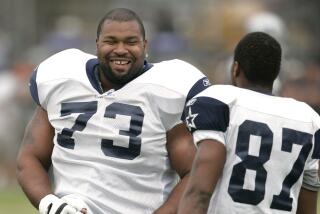Landry, One of a Kind, Dies at 75
- Share via
Tom Landry, the stoic man in the fedora who coached the Dallas Cowboys from lowly expansion team to two-time Super Bowl winners, died Saturday evening at Baylor University Medical Center. He was 75.
Landry was surrounded by his family as he succumbed to myelogenous leukemia, a disease he had been fighting since May.
Through their first 29 years in the NFL, the Cowboys were 270-178-6 under Landry and came to be known as “America’s Team.”
But Landry’s head coaching career came to an abrupt halt on Feb. 25, 1989, when he was fired by new team owner Jerry Jones after his third losing season in a row. Before that, Landry’s teams had 20 consecutive winning seasons, won 13 division titles and two Super Bowl games in five appearances. He ranks third all-time in coaching victories, behind only Don Shula and George Halas.
Under Landry, the Cowboys reflected the stability of a coach whose public persona was one of a ramrod straight, deeply religious man. That played particularly well in Texas, where football and religion are frequently confused.
Indeed, Landry spent his final years after leaving the Cowboys devoted to work for Christian organizations and concentrating on his business endeavors.
“He shaped my philosophy on everything,” Atlanta Falcon Coach Dan Reeves told the Associated Press on Saturday night. “I followed his philosophy on football and how he handled himself on and off the field. He was a tremendous influence on me.
“He was something unique to the NFL. He was someone who had tremendous knowledge of the NFL, but he was also a man of such integrity. He had a strong Christian faith that was unusual at that time. And he didn’t just talk it. He walked it too.”
As a Texas institution, Landry was a perfect public fit for the Cowboys, themselves a Texas institution from their inception. He was conservative--the ever-present felt hat covered a bald head--but with an offensive football flair; stolid, with nicknames “Mt. Landry” and “God’s Coach”; emotionless, even while standing on a sideline surrounded by emotional people, and always aloof, calculating, mission-oriented.
Occasionally disdaining.
Once, at a news conference in the days before Super Bowl XIII at Miami, he was asked to explain why the Cowboys’ famed Flex defense was different from any other defensive 4-3 alignment.
Landry paused, looked out over a gathering of the flower of American sportswriting and saw weeds.
“I don’t think I see anybody here who I think could understand it,” he said.
It was left for reporters to seek out tackle Jethro Pugh, no Rhodes Scholar while at Elizabeth City State, to get an explanation that the Flex was merely a zone-type defense set up for the middle linebacker to make a lot of tackles.
But that was Landry.
One day at practice, Cornell Green intercepted a pass by Don Meredith and Meredith chased Green all over the field, waving his helmet as if to hit the defensive back. The team broke up.
The coach didn’t, and the next day at a team meeting said, “Gentlemen, nothing funny ever happens on a football field . . . if we can help it.”
The Cowboys were the first NFL team to use a computer in scouting. Critics--some of them Dallas players--said they had one as their coach.
He seldom did anything on a football field without a reason, and most of those reasons stemmed from one premise: “The primary challenge of coaching in the National Football League can be boiled down to a one-sentence job description: To get people to do what they don’t want to do in order to achieve what they want to achieve,” Landry wrote in his autobiography.
So he had a reason for his stoic demeanor: “The execution of our system required calm, clear, instantaneous decision-making on the sidelines as well as on the field. My players didn’t want to see me rushing around and screaming; that would have been demoralizing, not motivating. They had to believe I was in control and knew what I was doing.”
And for distancing himself from the Cowboy players: “I felt if I got too close to my players, they would be tempted to use that personal relationship as a crutch. And it would have made it harder to push them to achieve their best. I felt I could protect them from that temptation to slack off and take advantage of a relationship if I maintained a little distance.”
Some Cowboys, notably receiver Pete Gent and lineman Pat Toomay, believed that “little distance” was ocean-vast and made it easier to get rid of players management figured could no longer be counted upon to win games. They used the demeanor in novels including characters that were thinly disguised Landrys.
Said former Dallas quarterback Roger Staubach, who led Landry’s two Super Bowl champions but who feuded with him publicly about running the Cowboy offense: “To me, Tom Landry is the greatest coach in the history of the game.”
That didn’t keep Staubach from firing back at Landry when the coach met him coming off the field after an interception and asked, “Why did you throw that pass? The defensive man had him covered.”
Responded Staubach, “Why did you call such a ridiculous play?”
Landry joined the expansion Cowboys late in 1959 after having spent six seasons as defensive coach of the New York Giants, for whom he had played as a defensive back and punter.
The Giants’ offensive coach was an assistant brought in from West Point, Vince Lombardi.
With the Giants, NFL champions in 1956, Landry saw the essence of delegation.
“With Lombardi coaching the offense and Landry coaching the defense, all I ever had to do is keep the balls pumped up and enforce curfew,” Coach Jim Lee Howell said.
That lesson didn’t take with Landry, a hands-on coach with the Cowboys who insisted on calling the plays, putting his stamp on the defense and influencing the scouting.
While Lombardi’s Green Bay Packers were dominating pro football in the 1960s, Dallas was laying a foundation that would make them the team of the ‘70s and take them into the future.
At the core of that foundation was Landry, who had signed a five-year contract and was paid $34,500 for going 0-11-1 in his first season.
There followed records of 4-9-1, 5-8-1 and 4-10, and Landry, who had come to town talking of a five-year plan for winning, was going into the final year of his contract hearing North Texas boo birds.
Cowboy owner Clint Murchison Jr. responded with a 10-year contract extension, to begin with the expiration of Landry’s current contract. A pattern was set that made him the Cowboy coach for 29 seasons.
Landry was a schoolboy football hero in Mission, a small grapefruit-growing town tucked into the Rio Grande Valley. From there, he went to the state university in Austin, where he played football and also met Alicia Wiggs, who would become his wife.
He interrupted his time at Texas with three years in the Army Air Corps during World War II as a co-pilot, flying 30 missions in a B-17.
Landry is survived by Alicia Landry, his wife of 50 years; a son, Tom Landry Jr.; and a daughter, Kitty Phillips. Another daughter, Lisa Childress, died in 1995 after a four-year battle with liver cancer. Funeral arrangements had not been announced at edition time.
(BEGIN TEXT OF INFOBOX / INFOGRAPHIC)
Tom Landry: 1924-2000
* NFL coach: Dallas Cowboys’ first coach, from 1960-88.
* Career record: 270-178-6, ranks third all-time for victories behind Don Shula (347) and George Halas (318).
* Winning percentage: .601, ranks 13th among coaches with at least 100 victories. Vince Lombardi is first at .740.
* Super Bowl: Two Super Bowl championships (1972 and ‘78) in five appearances (‘71, ’76 and ‘79).
* NFC East: 13 division titles; 20 consecutive winning seasons.
* Impact: Responsible for such innovations as the 4-3 Flex defense, the shotgun formation as a passing offense, computer use in player evaluation, and employing strength and quality control coaches.
* Hall of Fame: Inducted into the Pro Football Hall of Fame in 1990.
More to Read
Go beyond the scoreboard
Get the latest on L.A.'s teams in the daily Sports Report newsletter.
You may occasionally receive promotional content from the Los Angeles Times.










